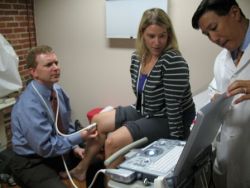Drexel Sports Medicine Uses High-Tech Equipment to Heal
October 12, 2010

Did you know the same technology used to monitor babies in the womb is now being used in sports medicine offices? Ultrasound imaging can help diagnose injuries to tendons and ligaments in knees, shoulders, wrists and other areas that are often injured during physical activities.
“When a patient comes in with a knee injury, for example, we can see movement in real time and in minutes are able to see any tears, internal bruises or excess fluid,” explains Hong. “If there is an injection needed, to decrease swelling or treat pain, we can pinpoint the targeted area through the monitor. This precision allows for spot treatment.”
Ultrasound imaging in sports medicine relies on high-frequency sound waves that are transmitted through the skin, overlying areas of interest such as the wrist, shoulder or knee. Higher frequency sound waves provide more detailed images.
Tendon,  muscle, ligament and joint-related injuries can be difficult to evaluate using x-rays, CT scans, or MRIs. Among its many advantages, ultrasound imaging does not use ionizing radiation, and therefore can be repeated throughout the course of treatment without concern for the total amount of radiation delivered to the patient.
In addition to helping diagnose injuries, ultrasound can also help treat them. The imaging technology is used as part of the latest trend in sports injury treatment known as platelet rich plasma or PRP therapy. PRP is one of three ingredients that make blood, the other two being red and white blood cells. When injected at a concentrated dosage into the injured area, PRP acts as the body’s own medicine to accelerate the healing process.

The ultrasound equipment enables the doctor to precisely guide the platelet rich plasma to the exact location of injury.
“Many injuries in our active patients can be treated with PRP as opposed to surgery,” says Bradley J. Sandella, DO, assistant professor, Division of Sports Medicine at Drexel University College of Medicine, who also performs the procedure at Drexel Sports Medicine in Manayunk. “This is a 45 minute out-patient procedure that can have an active patient healed and back to work or play within weeks.”
Surgery is usually the only other option for severe sprains and tendon injuries. With PRP therapy, the patient does not have to undergo the risk factors associated with in-patient surgical procedures.
“Since the blood used is the patient’s, there is no risk for contamination, allergy or drug reactions. Additionally, platelets have antibiotic properties, further reducing any risk of infection,” says Sandella.
In addition to using ultrasound and PRP, the Drexel Sports Medicine practice treats patients of all ages, activity levels and athletic abilities. From properly conditioning your body for upcoming physical activities and competitions, to the diagnosis and treatment of concussions and shin splints, Drexel Sports Medicine physicians stay at the top of their game when it comes to caring for you.
Learn more about the Drexel Sports Medicine practice.